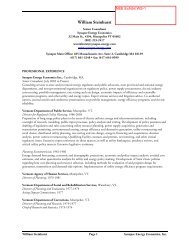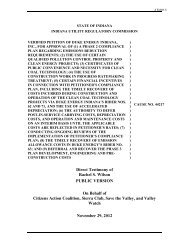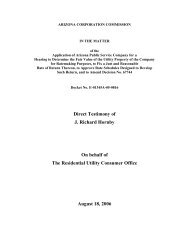Best Practices in Energy Efficiency Program Screening - Synapse ...
Best Practices in Energy Efficiency Program Screening - Synapse ...
Best Practices in Energy Efficiency Program Screening - Synapse ...
You also want an ePaper? Increase the reach of your titles
YUMPU automatically turns print PDFs into web optimized ePapers that Google loves.
Oregon also applies a 10 percent cost adjustment factor, which is applied differently <strong>in</strong>to<br />
the efficiency program cost screen<strong>in</strong>g. The 10 percent adjustment factor is added to the<br />
cost of avoided electricity supply to provide advantages for efficiency and conservation<br />
measures. This adder represents the various benefits (such as risk mitigation,<br />
environmental benefits, and job creation) of energy efficiency <strong>in</strong> general that are not<br />
reflected <strong>in</strong> the market. The NWPCC advocated the use of the adder and the Oregon<br />
PUC has mandated it <strong>in</strong> its order UM551.<br />
In addition to this type of cost adjustment factor, the <strong>Energy</strong> Trust of Oregon, and the<br />
statewide energy efficiency provider <strong>in</strong> the state, has applied some risk hedge values<br />
developed by the NPWCC to the benefit of energy efficiency. The NPWCC <strong>in</strong> its Fifth<br />
Power Plan conducted an analysis of energy efficiency programs as a hedge aga<strong>in</strong>st<br />
risks associated with high power prices or marked exposure. The Power Plan found that<br />
additional conservation measure above the cost-effectiveness threshold lower system<br />
cost without add<strong>in</strong>g risk. Specifically, the Council identified $5/MWh of risk avoidance for<br />
discretionary programs (i.e., retrofit) and $10/MWh of risk avoidance for lost opportunity<br />
programs (i.e., new construction program) to be the optimal additional values above the<br />
cost-effectiveness threshold to screen out cost effective DSM measures because such<br />
thresholds resulted <strong>in</strong> the reduction <strong>in</strong> the total cost and risk for each plan (ETO 2005;<br />
Braman 2009). 31 The <strong>Energy</strong> Trust of Oregon is currently revisit<strong>in</strong>g this issue and<br />
plann<strong>in</strong>g to use the hedge values developed by two local <strong>in</strong>vestor owned utilities,<br />
PacifiCorp and Portland General Electric <strong>in</strong> their most recent IRPs (Gordon 2012).<br />
Recommendations<br />
<strong>Efficiency</strong> screen<strong>in</strong>g practices should properly account for the risk benefits of energy<br />
efficiency, either through system model<strong>in</strong>g or through risk adjustments to the energy<br />
efficiency benefits.<br />
31 <strong>Energy</strong> Trust of Oregon 2005. Risk Avoidance Value for <strong>Energy</strong> <strong>Efficiency</strong>, a summary of Risk<br />
Avoidance Value <strong>in</strong> the 5th Power Plan prepared for the <strong>Energy</strong> Trust of Oregon staff, November 2005;<br />
Personal communication with Matt Braman at the ETO on January 15, 2009<br />
<strong>Best</strong> <strong>Practices</strong> <strong>in</strong> <strong>Energy</strong> <strong>Efficiency</strong> <strong>Program</strong> Screen<strong>in</strong>g | www.nhpci.org | 49







